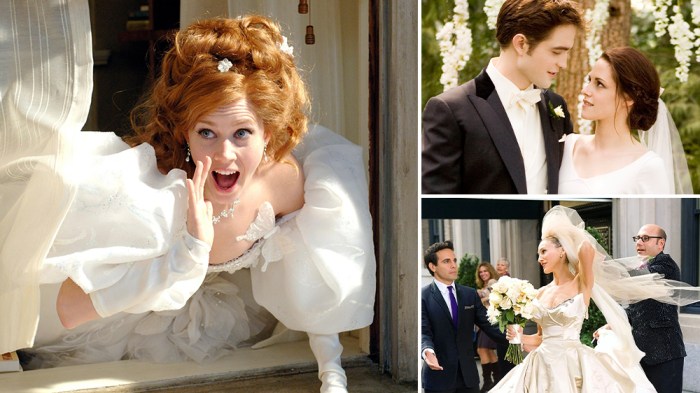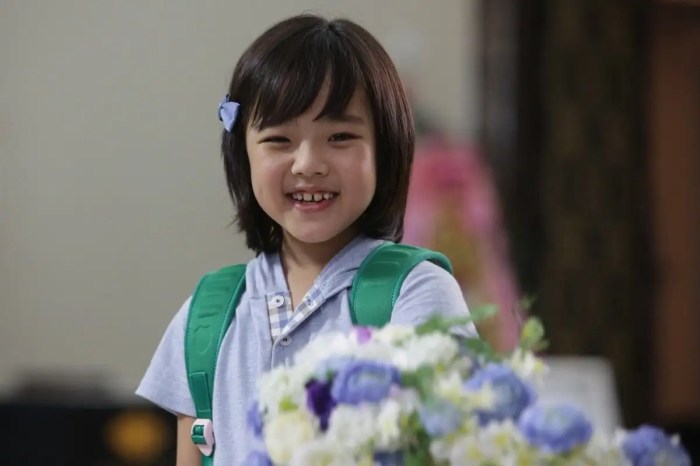The Wedding Dress Film A Comprehensive Analysis
The Wedding Dress: A Narrative Exploration: The Wedding Dress Film

Source: variety.com
The wedding dress film – This analysis delves into the intricacies of “The Wedding Dress,” exploring its plot, character development, visual elements, and directorial choices. We will examine the film’s central conflict, thematic explorations, and its overall impact on viewers and critics alike. The analysis will also consider the film’s setting, atmosphere, and the director’s stylistic contributions to the narrative.
The Film’s Plot and Themes
The central conflict in “The Wedding Dress” revolves around [ Insert a brief, spoiler-free description of the central conflict. E.g., a bride’s struggle with a difficult family situation, or a clash between tradition and modernity surrounding a wedding.]. This conflict serves as a catalyst for exploring major themes such as [ List 2-3 major themes, e.g., family relationships, societal expectations, personal identity, etc.]. The significance of these themes lies in their exploration of [ Explain the significance of each theme in relation to the film’s narrative and message. E.g., how the film portrays the complexities of family dynamics, challenges societal norms, or highlights the journey of self-discovery.].
The film’s plot unfolds through [ Give a concise summary of the plot, highlighting key turning points and events without revealing major spoilers.]. A crucial turning point occurs when [ Describe a key plot point and its impact on the narrative.]. Another significant moment is [ Describe another key plot point and its consequences.]. The contrasting motivations of the main characters, [ Name the main characters], significantly shape the narrative. [ Compare and contrast their motivations and the impact on the storyline. E.g., one character’s desire for tradition versus another’s yearning for independence.].
The film employs symbolism and imagery, such as [ Give examples of symbolism and imagery used, and their meaning within the context of the film. E.g., the wedding dress itself, recurring motifs, specific colors, etc.], to enhance the emotional impact and deepen the thematic resonance.
Character Analysis
The film features a compelling cast of characters, each with distinct personalities and arcs. Below are profiles of the key players and their relationships.
| Character Name | Personality | Relationships | Character Arc |
|---|---|---|---|
| [Character 1 Name] | [Description of personality traits] | [Relationships with other characters] | [Description of character’s transformation or journey] |
| [Character 2 Name] | [Description of personality traits] | [Relationships with other characters] | [Description of character’s transformation or journey] |
| [Character 3 Name] | [Description of personality traits] | [Relationships with other characters] | [Description of character’s transformation or journey] |
The protagonist’s evolution is particularly noteworthy. [ Describe the protagonist’s initial characteristics and how they change throughout the film.] The antagonist’s motivations stem from [ Explain the antagonist’s motivations and their role in driving the plot forward.]. The relationships between the characters are complex and multifaceted, with [ Describe the relationships between key characters and their dynamics, highlighting any significant conflicts or alliances.].
Setting and Atmosphere
The film’s setting plays a crucial role in shaping its narrative and mood. [ Describe the film’s setting and its impact on the story. E.g., a rural village, a bustling city, a specific historical period.] The atmosphere is masterfully crafted through cinematography, music, and sound design. [ Detail how these elements contribute to the film’s overall mood and tone. E.g., use of specific lighting, musical scores, or sound effects to evoke emotions like joy, tension, or sorrow.]
- Scene 1: [ Description of the scene and its atmosphere.]
- Scene 2: [ Description of the scene and its atmosphere.]
- Scene 3: [ Description of the scene and its atmosphere.]
The director utilizes visual elements such as [ Provide specific examples of how the director uses visual elements to enhance the emotional impact of the film. E.g., close-ups, slow motion, specific camera angles.] to amplify the emotional impact on the audience.
Directorial Style and Techniques
The director’s stylistic choices are evident throughout the film. [ Identify the director’s stylistic choices and their effect on the audience. E.g., use of specific camera angles, editing techniques, pacing, etc.] The film’s narrative structure is [ Describe the film’s narrative structure and its effectiveness. E.g., linear, non-linear, episodic.]. [ Compare the director’s style in “The Wedding Dress” to their other works, if applicable.] The director employs mise-en-scène effectively to convey meaning and emotion through [ Explain how the director uses mise-en-scène to convey meaning and emotion. E.g., set design, costumes, lighting, actor positioning.].
Critical Reception and Legacy
Upon its release, “The Wedding Dress” received [ Summarize the film’s critical reception. E.g., positive reviews, mixed reactions, negative criticism.]. The film’s cultural impact is evident in [ Discuss the film’s cultural impact and lasting legacy. E.g., its influence on other films, its contribution to discussions about specific social issues.]. [ Mention any awards or recognition the film received.] The film’s influence can be seen in [ Share examples of how the film has influenced subsequent works in the same genre.]. Critics and audiences have offered diverse interpretations of the film, with some focusing on [ Elaborate on the different interpretations and analyses of the film by critics and audiences.].
Visual Elements and Design, The wedding dress film

Source: idntimes.com
The costumes in “The Wedding Dress” are significant in conveying character and thematic elements. [ Describe the costumes and their significance in the film’s narrative. E.g., the symbolism of the wedding dress itself, the contrast between characters’ clothing styles.] The production design and set decoration contribute significantly to the overall aesthetic. [ Detail the production design and set decoration, explaining their impact on the overall aesthetic.]
[Create a detailed description of a key scene, focusing on the visual elements. Describe lighting, color palette, costumes, set design, and camera angles. E.g., “The climax of the film takes place in a dimly lit ballroom. The protagonist, dressed in a stark white wedding gown, stands silhouetted against a backdrop of deep crimson drapes. The camera focuses on her face, highlighting her conflicted expression. The low-key lighting accentuates the dramatic tension, emphasizing the weight of her decision.”]
Color plays a crucial role in establishing mood and symbolism. [ Discuss the use of color in the film and its symbolic meaning. E.g., the use of white to represent purity, black to represent darkness, or specific color schemes to evoke different emotions.] Lighting choices are particularly effective in shaping the atmosphere. [ Illustrate the impact of lighting choices on the mood and atmosphere of specific scenes. Provide deep descriptions of lighting, avoiding image links. E.g., “The scene in the garden is bathed in warm, golden light, creating a sense of serenity and hope. In contrast, the scenes inside the family home are often shrouded in shadows, reflecting the underlying tension and conflict.”]
Questions and Answers
What is the film’s runtime?
The runtime varies depending on the version; check specific release information.
Where can I watch The Wedding Dress Film?
Availability depends on your region; check streaming services or local cinemas.
The Wedding Dress film beautifully portrays the emotional journey of finding “the one,” and while the film focuses on the main character’s experience, it also subtly highlights the broader world of wedding attire. For those attending a summer wedding, finding the perfect outfit is crucial, and thankfully, there are many stunning options available, such as those found at plus size summer dresses for wedding.
Ultimately, the film reminds us that the true essence of a wedding lies in the celebration of love, regardless of the dress code.
Who composed the film’s score?
This information is typically available in the film’s credits or online resources.
What awards did the film win or receive nominations for?
Information on awards and nominations can be found on film award websites and databases.





















